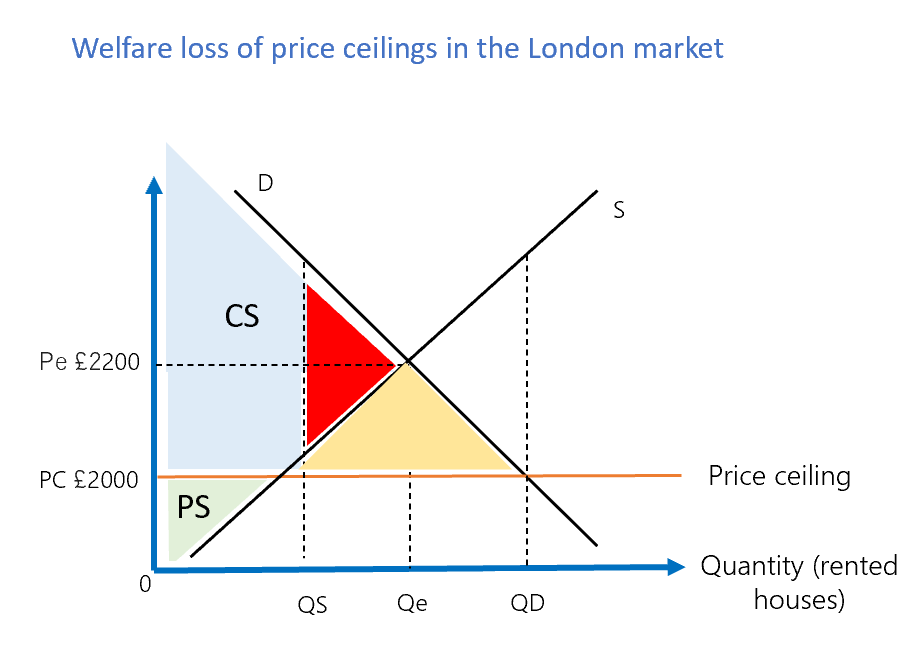IB Microeconomics
Real World Examples (RWE's) Price Ceiling
Could the UK government be about to implement rent controls (an example of a price ceiling) in London?
Why would a price ceiling be implemented?
Well, a price ceiling is a price set below equilibrium in order to help consumers afford rent. So, is this something that needs implementing?
A recent article states: “Rents in some London boroughs have jumped by 50% in the last decade and could do so again in the next ten years“!
The research will increase fears that the capital is becoming impossible to afford for all but the most privileged and that there will be a “brain drain” of talent away from London, especially among the young!
In some parts of London renting requires tenants to spend 64% of their yearly income on rent! This is up from 43% just 10 years ago.
“This means that those reliant on the rental sector in order to live can face incredible competition and even bigger problems when it comes to obtaining a mortgage”!
Let’s have a look at the effects of a possible rent control (price ceiling)
Diagram 1 shows the market for rental properties in London at equilibrium before a possible price ceiling is implemented. The market price is £2200 per month. Both consumer (blue) and producer surplus (green) are balanced roughly equal.
Would a London price ceiling (rent control) work?
From diagram 2 it can be seen that; market price would be limited to the price ceiling (at £2000), which benefits renters and disadvantages landlords. Consumer surplus increases (blue). This could help to improve equity, reduce the percentage of salary required to pay rent, which could help renters to save to get a mortgage and buy their own property. This could help some renters escape the property trap. This intervention could enhance economic wellbeing, but it is not without costs and problems.
From diagram 2 you can see that an excess demand is created (yellow triangle) as supply of houses to rent falls. This creates a social welfare loss (red triangle) as quantity supplied of houses for rent falls from Qe to Qs, exacerbating the initial problem.
In a practical sense, there may also be problems! For example, the government stipulates that, “landlords must be fair and realistic about rental increases, and any rent rise must be in line with the prices of other local properties”.
Landlords may interpret “fair” differently and be more interested in the market price than intervention prices. Also, rent prices can be negotiated upwards at the end of contracts! This may encourage landlords to issue short term contracts to allow them to keep raising rents and circulate tenants more aggressively, which could add to housing insecurity and provide a loophole for any rent ceiling legislation implemented by government!
Even more seriously, landlords may also choose to withdraw their properties from the market by selling if they feel that the return (rent) is falling! This could create even greater scarcity of properties for renters.
However, if this happens on a wide enough scale, this increase in supply could help to reduce purchase prices across London due to an increase in supply, which could make mortgages and buying more affordable!
Politically, interfering with the rental market is unpopular and often it is claimed that the best way to fix rental market is by supplying more new build homes to the market! This would be a solution if land weren’t so scare and there wasn’t such a long lead time from starting new builds to completion! Add to this, increasing immigration pressures on a highly inelastic supply of housing, which leads to higher demand.
It seems unlikely that the free market can solve the problem in the short run, particularly as homes are now seen as an investment class, rather than just a place to live!
In this sense, it would seem that in the short term, rental controls in London could be useful, but fall short of solving the problem with that single measure!


Diagram 1: Indicating market equilibrium before a price floor is implemented.

Diagram 2: The resulting effects of a price ceiling being implemented.






